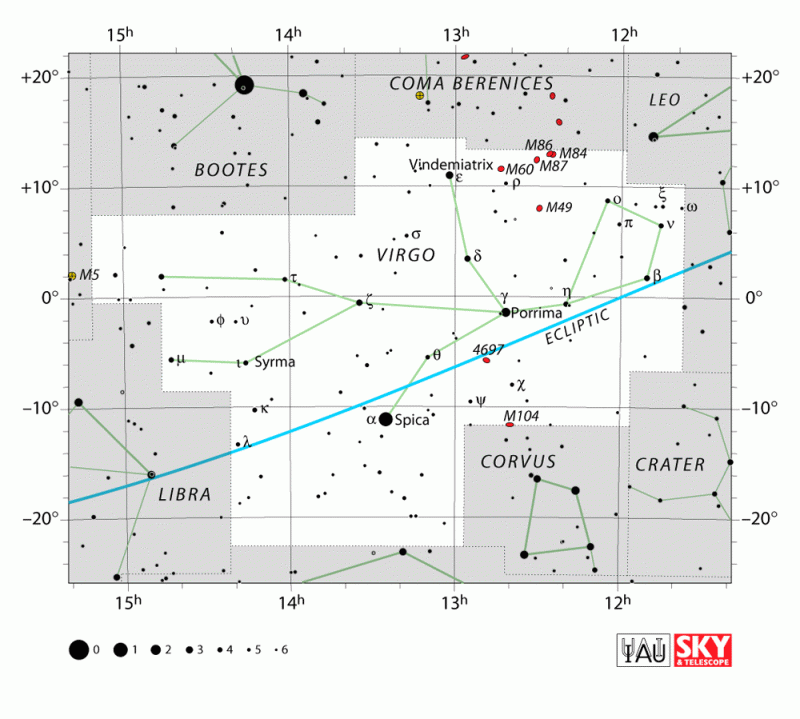
Tonight – April 26, 2018 – the waxing gibbous moon shines to the north of the celestial equator, whereas the the bright star Spica lies to the south of it. The celestial equator is Earth’s equator projected onto the imaginary sphere of stars encircling Earth. At present, the moon resides in the sky’s northern hemisphere. But – in a day or two – the moon will cross the celestial equator to enter the southern half of the starry sky.
The celestial equator isn’t a necessary concept to know for everyday stargazing. You can watch the stars for decades and never give it a thought. But the celestial equator is a useful tool for mapping the sky, in understanding how this imaginary great circle divides the celestial sphere into its northern and southern hemispheres.
The celestial equator (declination of 0o) passes through the zodiacal constellation Virgo the Maiden. (See the sky chart below.) So when the moon sweeps through Virgo during its monthly trips through the constellations of the zodiac, we can expect the moon to cross the celestial equator going from north to south. Declination on the sky’s dome is the equivalent of latitude here on Earth.

Virgo constellation chart via the International Astronomical Union (IAU)
Want to know which constellation the moon is in front of right now, and the moon’s present declination? Click here.
After tonight, the moon will continue to travel farther south on the sky’s dome, until reaching its southernmost declination of 20.56o on May 4, 2018. The moon will go northward again to cross the celestial equator – going from south to north – on May 12, 2018. Then, the moon will sweep to its northernmost declination of 20.65o on May 18, 2018.
Sometimes, the moon’s northernmost or southernmost point for the month is referred to as a lunar standstill or lunistice. In a major standstill year, the moon’s monthly swings in declination are from about 28.5o north to 28.5o south (2006 and 2025). In a minor lunar standstill year, the moon bounces back and forth from about 18.5o north to 18.5o south each month (2015 and 2034).
In the meantime, enjoy tonight’s moon, which is soon to cross the celestial equator.
Resources:
Monthly lunar standstills: 2001 to 2100
Moon via Heavens Above satellite page
from EarthSky https://ift.tt/2HuBcyZ

Tonight – April 26, 2018 – the waxing gibbous moon shines to the north of the celestial equator, whereas the the bright star Spica lies to the south of it. The celestial equator is Earth’s equator projected onto the imaginary sphere of stars encircling Earth. At present, the moon resides in the sky’s northern hemisphere. But – in a day or two – the moon will cross the celestial equator to enter the southern half of the starry sky.
The celestial equator isn’t a necessary concept to know for everyday stargazing. You can watch the stars for decades and never give it a thought. But the celestial equator is a useful tool for mapping the sky, in understanding how this imaginary great circle divides the celestial sphere into its northern and southern hemispheres.
The celestial equator (declination of 0o) passes through the zodiacal constellation Virgo the Maiden. (See the sky chart below.) So when the moon sweeps through Virgo during its monthly trips through the constellations of the zodiac, we can expect the moon to cross the celestial equator going from north to south. Declination on the sky’s dome is the equivalent of latitude here on Earth.

Virgo constellation chart via the International Astronomical Union (IAU)
Want to know which constellation the moon is in front of right now, and the moon’s present declination? Click here.
After tonight, the moon will continue to travel farther south on the sky’s dome, until reaching its southernmost declination of 20.56o on May 4, 2018. The moon will go northward again to cross the celestial equator – going from south to north – on May 12, 2018. Then, the moon will sweep to its northernmost declination of 20.65o on May 18, 2018.
Sometimes, the moon’s northernmost or southernmost point for the month is referred to as a lunar standstill or lunistice. In a major standstill year, the moon’s monthly swings in declination are from about 28.5o north to 28.5o south (2006 and 2025). In a minor lunar standstill year, the moon bounces back and forth from about 18.5o north to 18.5o south each month (2015 and 2034).
In the meantime, enjoy tonight’s moon, which is soon to cross the celestial equator.
Resources:
Monthly lunar standstills: 2001 to 2100
Moon via Heavens Above satellite page
from EarthSky https://ift.tt/2HuBcyZ

Aucun commentaire:
Enregistrer un commentaire